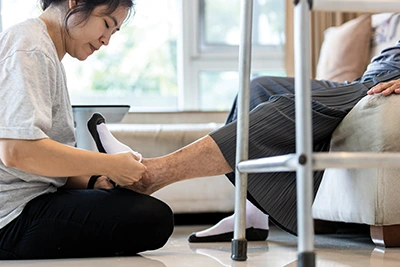
When diabetic wounds threaten a limb, patients aren’t the only ones who suffer pain and anxiety. Family caregivers share the burden—and lack of information about limb loss ranks as a major source of stress.
That’s one of the key findings from a paper published last fall in the Western Journal of Nursing Research. Titled “Informal Family Caregiving of Patients with Diabetic Extremity Wounds,” the study found that “increased caregiver burden and decreased quality of life were associated with higher patient amputation level.”
The article is based on a review of ten previously published studies involving more than 600 informal family caregivers, defined as individuals who provide uncompensated support to a relative with a limb-threatening diabetic foot wound. The majority of the caregivers in the study set were women. Most fell between 50 and 69 years old, and they were typically retired, unemployed, or working from home. “These caregivers have a vital role in wound care, assisting the patient with activities of daily living, medication adherence, psychosocial support, and obtaining follow-up services,” the authors noted. Most important, informal family caregivers “bridge the divide between patients and multiple points of care.”
Unfortunately, that bridge rests on a rickety foundation. The study’s subjects routinely cited two major obstacles to effective diabetic wound care: 1) insufficient guidance from doctors and other healthcare providers, and 2) lack of access to reliable information sources. “Many caregivers reported minimal communication with clinicians regarding appropriate wound care, what to expect with wound progression, and feeling as though they had no ‘backup’ from professional healthcare,” the authors observed.
This dynamic leaves caregivers feeling helpless, anxious, and ineffective. It also amplifies the number-one source of stress that caregivers report: the possibility of amputation. This is particularly acute in cases where limb loss would significantly impact the income level of the patient and/or household. According to the paper, “Poor or inconsistent communication with the healthcare team, perceived helplessness, and anxiety contributed to attempts of families to ‘bargain’ with providers over holding off on amputation.” If the patient does end up losing a limb, caregivers often feel as though it’s their fault and become overwhelmed with guilt—which, in turn, makes them less confident and less effective in supporting the new amputee.
“Healthcare providers should provide clear, consistent, and continuous education to informal caregivers to reduce their psychological stress,” the study concluded, “while also positively impacting the informal care received by the patient”—and, ultimately, reducing the number of preventable amputations. Finally, the authors recommended four steps healthcare professionals can take to give caregivers better support:
- Improve communication by providing multiple points of contact for patients, including telehealth portals.
- Create an online knowledge base where caregivers can access resources and pose questions.
- Maintain routine contact with caregivers, rather than waiting for emergencies to arise.
- Schedule appointments that accommodate the caregiver’s other needs (such as work, family, or self-care).
In addition to whatever support their health providers offer, caregivers and patients can and should equip themselves with information. A starter list of resources includes:




